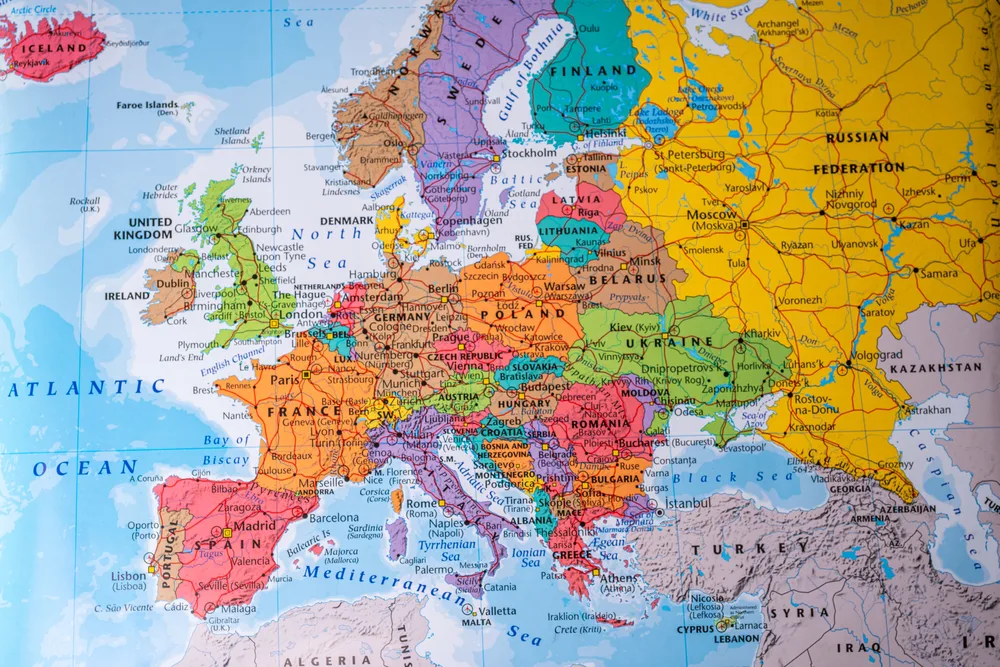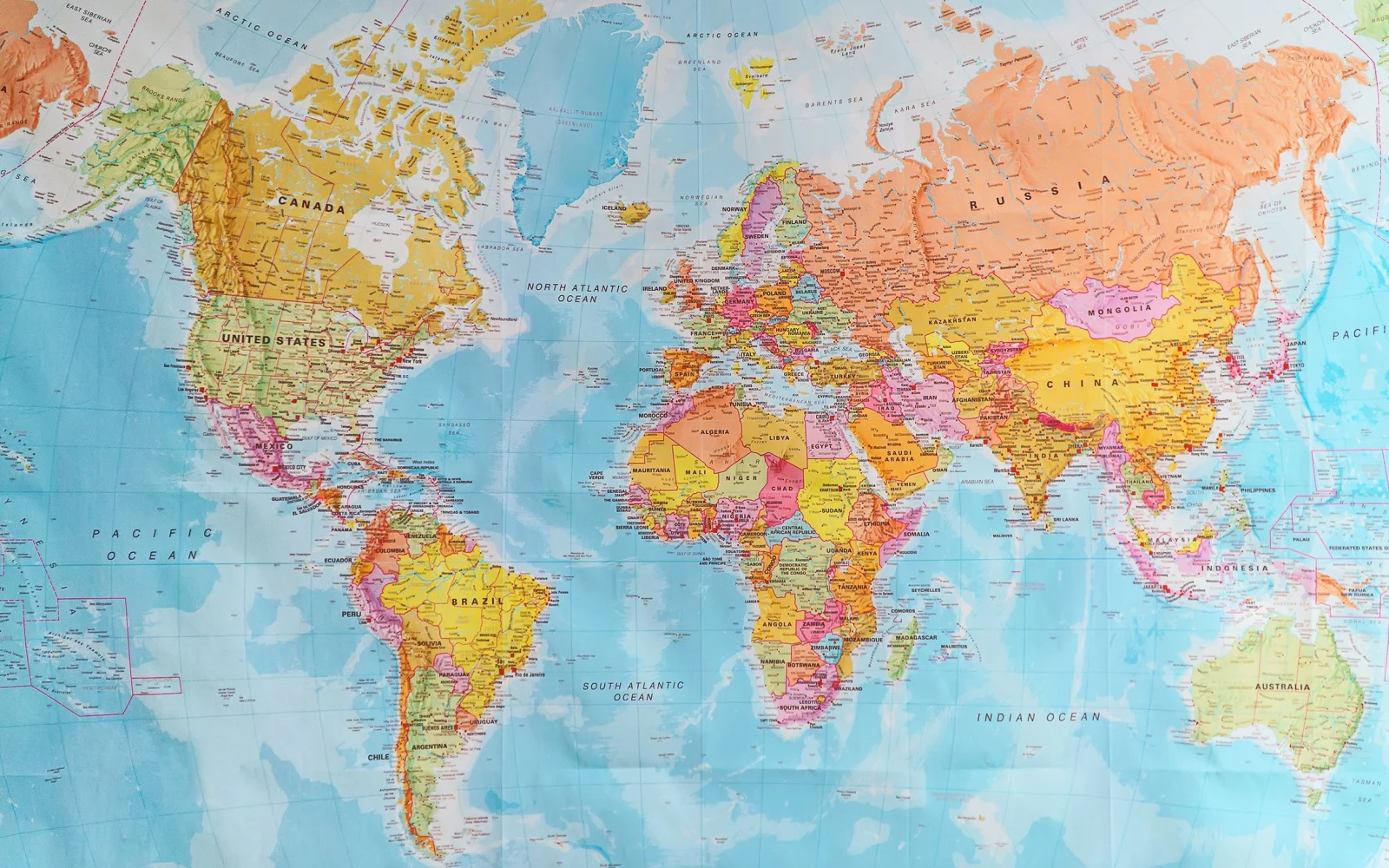How big is Europe compared to the US?
Europe and the United States are surprisingly similar in size, with Europe being only slightly larger. Europe’s land area is about 3.9 million square miles, approximately 5% larger than the U.S., which has a land area of about 3.7 million square miles.
Europe is a whole continent, so you’d think it would be bigger than a country… right?
Weirdly, not really. Europe and the United States are actually a lot closer in size than you might realize, which makes for a fascinating exercise in geography and geopolitics alike. Since you know how much we love Europe, we thought it would be a good idea to consider the two here.
A complicating factor is the simple fact that how big Europe is compared to the US depends on what type of “size” you’re asking about.
You can compare land area, marine territory, population, or the number of political bodies within the larger whole. You can also consider its influence and potential for the future.
In this post, we’re going to do all of the above. No time to waste… keep reading!
How Big Is Europe Compared to the US?

Alexander Lukatskiy/Shutterstock
First, let’s clear up a misconception at the outset. Many readers get confused about the European Union, thinking it is synonymous with Europe. I mean, it’s right there in the name, after all.
Europe vs the EU
The EU is not the same as Europe and does not control its member nations’ choice to be included. They can opt-out, which is how Great Britain made waves with Brexit (British exit) in January 2020, when the withdrawal officially took place.
The EU includes 27 nations of Europe’s 44 to 50 (depending on which sources you believe, as we’ve discussed at length before), so it does not represent all of the Continent nor is it “the same as” Europe.
In our discussion, assume that “Europe” means all of the countries on the Continent, including the parts of Turkey and Russia that sit on the European peninsula even though the rest of each sits in Asia.
Total Land Area
The United States is big. Like, big big.
According to the Nations Encyclopedia, it “is the third-largest country in the world in area behind Russia and Canada. It has a total area of 9,629,091 square kilometers (3,717,792 square miles). This total includes the 50 states and the District of Columbia, but not the nation’s territories and dependencies.”
Let’s leave aside the question of territories for a moment and compare this main land area to Europe, which has “an area of 10.2 million km² (3,938,000 sq mi),” says Nations Online. That makes it “20% larger than the contiguous United States.”
Unfortunately, that leaves out Alaska and Hawaii.
This proves how dicey it is to measure landmasses, populations, the number of countries in a particular area, or anything else that has to do with world geography – which is why it’s a consistent problem you will find anywhere you look for questions of size.
However, if we use the rough numbers of 3.7 million square miles for the United States and 3.9 million for Europe, then it’s evident that Europe is only slightly bigger – around 5% or so.
That only includes landmass, though. Since nations with a coast extend outward into the sea, any discussion of size should include that as a consideration.
Total Marine Territory
Measuring a country’s or a continent’s “ownership” of the sea is tricky indeed. For one thing, we don’t really “own” the seas but rather control them. The area overseen by a particular country is referred to as an Exclusive Economic Zone, or EEZ.
According to the National Oceanic and Atmospheric Administration, an EEZ is “an area of the ocean, generally extending 200 nautical miles (230 miles) beyond a nation’s territorial sea, within which a coastal nation has jurisdiction over both living and nonliving resources.”
As you might assume from the word “exclusive,” it does not share this territory with other countries.
Given that control over resources as well as jurisdiction – the country gets to say what laws govern that part of the ocean or sea – we must include this in conversations about the respective sizes of the US and Europe.
So, how big are their economic zones?
EEZ Zone Comparison: US to Europe
“With more 3.4 million square nautical miles (4 million square miles) of ocean, the U.S. EEZ is larger than the land area of all 50 states combined and is one of the largest EEZs in the world,” says the NOAA.
They point out that only about 40 percent of it has been mapped, but that doesn’t stop America from claiming it.
Part of the reason the US EEZ is so large is because “This area includes Puerto Rico, Guam, American Samoa, the U.S. Virgin Islands, the Northern Mariana Islands, and other U.S. possessions.”
Now, how about Europe? Facts in this case are harder to find, because Europe is not a country but rather a collection of countries, and even those aren’t always on the same page (see the EU discussion above).
However, we can safely assume that the EEZ of combined Europe is larger than that of the United States, given that France’s EEZ alone is about 3.9 million square miles and Britain’s is 2.6 million.
Together, that makes 6.5 million, which is far larger than the US already, and the other 45-ish European countries aren’t even included. Granted, Britain and France are two of the biggest seafaring powers in Europe with long coastlines, so they likely have more than their share.
But the bottom line is that the US loses on this front.
Population Size

LONDON, ENGLAND, UK – MAY 30, 2009: Crowd of people in Oxford Street in London/Alex Segre/Shutterstock
The next measure of size you might use is population, and here Europe beats the United States handily.
“Even though the United States is the third-most highly populated country on the planet, it is not more populous than Europe,” explains WorldAtlas. “The United States has a population of over 327 million people, while Europe is home to more than 741 million individuals. Over 11% of the total world’s population resides in Europe.”
Because of this, the population densities of the two areas differ significantly. Says WorldAtlas again, “Europe has a population density of 188 individuals per square mile while that of the United States is 87 individuals per square mile.”
Even the European Union on its own beats the United States in terms of populace. It has a population of 448 million, which is still 121 million more than the US.
Most of the inhabitants of Europe live in Russia, Germany, the United Kingdom, France, Italy, Spain, Poland, Ukraine, Romania, and the Netherlands.
Number of Subsidiary Political Entities
Next up: how many distinct entities exist under the banners of the United States and Europe respectively? As discussed, Europe is a hard one to answer, because it ranges between 44 and 50 depending on whom you ask.
America isn’t that much easier, though. While the obvious reply is “fifty nifty United States, duh!” there’s also Washington DC as well as all the territories of the United States. If you take these together, the answer is well over 50.
That leaves us with one of two possible answers:
- They are equal if you don’t include Washington DC or the territories and you do include all of Europe’s disputed areas, or
- The United States wins if you take a straight-across approach to either one (no to the territories or yes to the territories)
As such, this one’s a bit more up in the air.
Europe and the USA: Futures Untold

kungfu01/Shutterstock
There’s no saying what will happen in the future to change the balance of power between these two mostly friendly political bodies.
One thing to consider is that humanity is currently taking its first tentative steps out into the solar system. For now, the United States has a massive space advantage over every country except Russia, with China creeping up behind the two.
While ESA (the European Space Agency) is a player, it is lagging. Another thing to consider is who wields the biggest say on a global stage.
Since none of the states hold any clout in this respect, while Europe’s many countries have standing in the United Nations and other international bodies, it’s a safe bet that Europe is politically “larger” in presence, if not more powerful.
For now, the United States and Europe often align on political and social issues, especially Western Europe.
That makes it a wonderful place to travel from the Americas – and perhaps even stay awhile, no matter how big the country you’re coming from or headed to. Happy travels!



